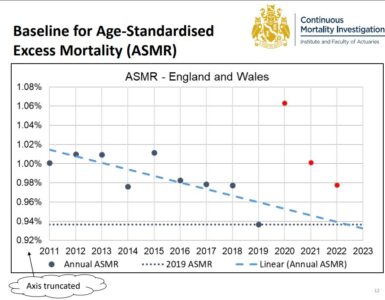We looked at World Health Organisation (WHO) estimates of excess deaths in last week’s blog. We raised concerns that the WHO figures for expected deaths looked odd for some countries.
Excess deaths are the difference between the number of deaths that actually occurred, from any cause, and the number that would have been expected in the absence of the COVID-19 pandemic.
The WHO has now said that it will revise its estimates of expected deaths. However, new concerns have since been raised about its figures for actual deaths.
Revision to WHO method for excess deaths
Our earlier blog noted concerns that the WHO approach for expected deaths appears overly sensitive to random fluctuations in mortality. It places too much weight on short-term noise rather than on the longer-term trend.
Professor Jon Wakefield, who worked on the WHO figures, has now expressed similar views on “More or Less” on the BBC World Service, saying that:
In 2019 there was a low observed number of deaths in Germany and that number influenced our model too much… we’ve actually redone the Germany estimate with a different expected number and we’ve got something now that looks more reasonable.
Prof. Jon Wakefield – WHO COVID-19 Mortality Assessment Technical Advisory Group
This is excellent news! We are grateful to the WHO team for listening to concerns and changing its approach.
WHO data for actual deaths
We said in our earlier blog that we would expect figures for actual deaths “to be fairly accurate (at least in developed countries)”. However, a reader told us that the figures used by the WHO for actual deaths in Sweden appeared to be wrong.
Having now looked into this, we have concerns with the WHO’s actual deaths figures for Sweden and some other countries.
Chart 1 compares the figures for actual monthly deaths used by the WHO with those published by Statistics Sweden.
- In 2020 and the first half of 2021, WHO figures are consistently 4-5% higher than the official figures.
- In the second half of 2021, WHO figures differ more wildly. The difference is 28% in December 2021.
Chart 1 – Monthly deaths in Sweden according to Statistics Sweden and the WHO

We have also compared the figures for actual monthly deaths in 2020 used by the WHO with those available from Eurostat. Eurostat Figures for 2021 are not yet available.
Of the 34 countries that we have been able to compare:
- The WHO and Eurostat figures agree exactly for only one country, Czechia.
- Deaths reported by the WHO for 2020 are higher than the Eurostat figures for 28 countries, and at least 5% higher than the EuroStat figures for 7 of these.
- The highest difference is for Albania, where the WHO figure is 42% higher than EuroStat.
- For Norway, the difference for 2020 as a whole is 1%, but WHO figures for individual months can differ from Eurostat by over 15%.
Discussion
The WHO faces a challenge in producing an estimate of global excess deaths, because deaths data is not readily available for many countries. This is particularly true in the developing world. Because of this, the WHO has estimated actual deaths for some countries using a statistical model. Estimating deaths is difficult, and WHO estimates for deaths in a few countries are twice as high as in the World Mortality Dataset.
It appears that the WHO may have estimated actual deaths for some countries even where high-quality data is available. This appears an odd choice. While estimates are needed for countries with missing or incomplete deaths data, it seems inappropriate for countries where good data exists, and makes the WHO results less reliable.
For example, the difference between the WHO’s actual deaths numbers and those published by Statistics Sweden is larger than the WHO’s calculated excess deaths. The discrepancy accounts for around half of the excess deaths in our own simpler estimate.














